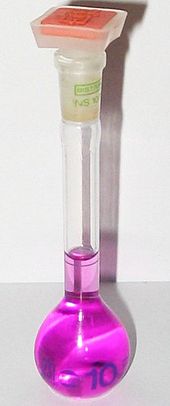Chromophore

The chromophore ( ancient Greek χρῶμα chrṓma , color ', φορός phorós ' bearing') is the name given to the entire coloring atom or ion grouping of a chemical compound or material. The color can be achieved through light absorption , light reflection , light scattering or light refraction .
The term chromophore is used in connection with organic dyes and pigments , as well as with inorganic colored glasses, in which the color is caused by embedded ions (e.g. cations of iron , nickel , cobalt , manganese , copper and chromium ) or by metal colloids ( e.g. copper and gold ).
In organic colorants , the molecules contain a chromophoric structure with delocalizable electrons. By selective light absorption of a photon of suitable energy, such electrons can be raised to a higher energy level; this puts this molecule in an energetically excited state.
A chromophore is not to be confused with a pigment-bearing organelle ( chromatophore ) of a cell or with a pigment cell ( chromatophores ).
Organic chromophores
Organic dyes and pigments have chromophores, which consist of a highly conjugated electron system.
With all of these substances the selective absorption of light quanta ensures electron transitions from the highest occupied molecular orbital ( HOMO ) of the chromophore to its lowest unoccupied molecular orbital ( LUMO ).
Typical organic chromophores are for example:
- Long chains of conjugated double bonds as in carotene or chlorophyll
- Aromatics linked by azo groups (A1) as in the azo dye methyl orange (A2) with the NR 2 group (right) as an auxochrome and the NaO 3 S group (left) as an antiauxochrome group
- Quinoid systems (B) as with the triarylmethane dyes alizarin , fuchsine or phenolphthalein
- Nitro compounds (C1) as in the aromatic nitro dye picric acid (C2) with the OH group as an auxochrome group
A1: azo group, A2: methyl orange, B: quinoid system, C1: nitro compound, C2: picric acid
The compounds often have other groups that enhance the color. According to Witt's dye theory , these are also referred to as auxochromes or auxochrome groups and antiauxochromes or antiauxochrome groups. For example, the absorption spectrum of a chromophore does not necessarily have to be in the visible range of the electromagnetic spectrum - if the chromophore is changed by the mesomeric effect of another substituent, this shifts i. d. Usually also its absorption spectrum. If the absorption spectrum is shifted into the shorter-wave range of the electromagnetic spectrum by the introduction of an auxochrome group , one speaks of a hypsochromic effect (blue shift). The shift into a longer-wave area is known as the bathochromic effect (redshift).
Dependence of the chromophoric system on the chemical environment
The indicator reaction of the phenolphthalein shows how the chemical environment - in this case the pH value - can change the chromophore and thus influence the color.
By deprotonation at pH> 8 is formed from the colorless phenolphthalein ( 1 ), opening the lactone ring of the red colored quinoid dianion ( 2 ), for which 2 mesomeric limiting structures can be formulated. At pH> 12, the hydroxy-substituted, colorless triphenylmethane compound 3 is formed . Under strongly acidic conditions the lactone ring of phenolphthalein is opened and the mesomeric-stabilized, colored cation 4 is formed with elimination of water .
Inorganic chromophores
In inorganic dyes, depending on the electron configuration of the chromophore , the color is based on charge transfer transitions or the excitation of electrons in the inner electron shell .
The mineralogy distinguishes between idiochromatischen and allochromatischen substances.
- In the case of idiochromatic substances, the chromophore is directly involved in the structure of the mineral, e.g. B. in the case of blue copper sulfate containing water of crystallization (anhydrous copper sulfate is white).
- Allochromatic substances, on the other hand, only contain traces of the chromophore. Ruby, for example, chemically consists primarily of aluminum oxide , but it only gains its color from traces of chromium that are built into the crystal lattice of the aluminum oxide.
Inorganic chromophores are often found among the transition metals . Examples are vanadium , chromium , manganese , iron , cobalt , nickel and copper . Depending on the oxidation level and complex formation , these elements can show very different colors, e.g. For example, manganese, which is also known as the “chemical chameleon”, is six different.
See also
- body paint
- Photochemistry
- Ligand field theory
- Absorption spectrum
- Bathochromic effect
- Hypsochrome effect
- Chromogenic process
Individual evidence
- ↑ Entry on chromophores. In: Römpp Online . Georg Thieme Verlag, accessed on July 19, 2019.
- ↑ Martin Klessinger: Constitution and light absorption of organic dyes . In: Chemistry in Our Time . tape 12 , no. 1 , 1978, p. 1–11 , doi : 10.1002 / ciuz.19780120102 .
- ↑ University of Regensburg: Demonstration Lectures in Inorganic Chemistry - Manganese (Mn) ( Memento from June 12, 2007 in the Internet Archive )
- ↑ Baden Canton School: The chemical chameleon (PDF; 260 kB)







